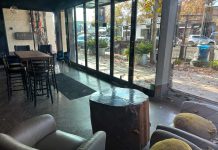

If you happen to be going through your granddad’s or grandma’s house, garage, attic or barn, it might be wise to think twice before throwing away all that “junk.” There could be gold in them thar heaps if you know what you’re doing.
At a farm auction last weekend on Holsclaw Road, Rich Chavarria, owner of Garlic City Auction, and a crowd of antique hunters proved that what’s old can still be sold, even if it’s a bit rusty.
Or a lot rusty. Chavarria brought an old rusty gas pump back to relevance on Saturday. Far after it fell into disuse and tossed in a shed, presumably never to be thought of again, the pump caught the eye of Robert and Katelyn Campos, who ultimately came out victorious in a bidding war, and paid $525 for the relic.
“Why not?” said Robert Campos, who works in the automobile industry, when asked why they’d pay $525 for something others would consider junk.
Katelyn, who enjoyed the bidding war, was more straightforward with her answer.
“It’s not my money,” she said, laughing.
Chavarria and Garlic City Auction have combed through the city’s barns and attics for the past 10 years. Chavarria is a self-taught auctioneer, and his training started 31 days before his first auction was hosted in a 10,000-square-foot building owned by Gary Walton. Since then, 500 sales later, Chavarria still revels in uncovering pieces of Gilroy’s history.
Chavarria has broken through what had been a “good ol’ boys” network of auctioneers, partially with the help of some innovative ideas and technology. Eschewing other auction styles, where various items from an estate would be sold together in one lot, he uses box lots, where customers have an opportunity to scout out what they want and organize them together in boxes. While the organizer may have an inside track, everyone has a chance to bid on box lots.
Since Garlic City Auction sells items by smaller lots, customers are better able to zero in on things that catch their eye. Sometimes, by fortunate accidents, Chavarria can find some hidden gems just by emptying an old bucket.
“I turned over an old coffee can and I said, ‘Wow,’” Chavarria said of the discovery of what he calls “rusty gold,” which in this case were several heart-shaped iron sprinkler heads. “Before I knew it, the sprinkler heads were selling for $50 to $60 apiece.”
A graduate of Silicon Valley College, Chavarria has leveraged his tech abilities to build websites and host video auctions to accompany live auctions. His extensive list of more than 6,000 email addresses has helped him create a substantial customer base.
Chavarria has some experienced help. Old-time auctioneer and cowboy “Sleepy” Avant, who Chavarria says was friends with Hank Williams Sr, Liberace and Sammy Davis Jr., among other luminaries, can pitch and sell with the best.
Aside from being an auctioneer, Chavarria is also a historian, but in a way, he’s also a community organizer. He takes pride in keeping Gilroy’s history in Gilroy and in bringing together old friends.
“I’m a historian all the time,” Chavarria said. “I don’t want things to leave Gilroy. But it’s also a social event. We have coffee, doughnuts, and some of the old-time farmers who come out to the auctions haven’t seen each other in 30 years. People don’t want to buy things because they want them; they do it because it’s fun.”
The Internet has introduced new layers to auctions. Offsite bidders can pursue notable items and make bids online. The online bids often set the base price that Chavarria can ask for a specific thing. The online auctions, however, can often bring in outsiders to bid on pieces of Gilroy history, such as the first post office bike ever used in Gilroy, which was ultimately bought by a San Jose resident for over $500.
“He said he wanted it so he could take it away from us, but I think he was just joking around with us,” Chavarria said. “It was just some good-natured kidding around.”
To check out future auctions, visit garliccityauction.com.













